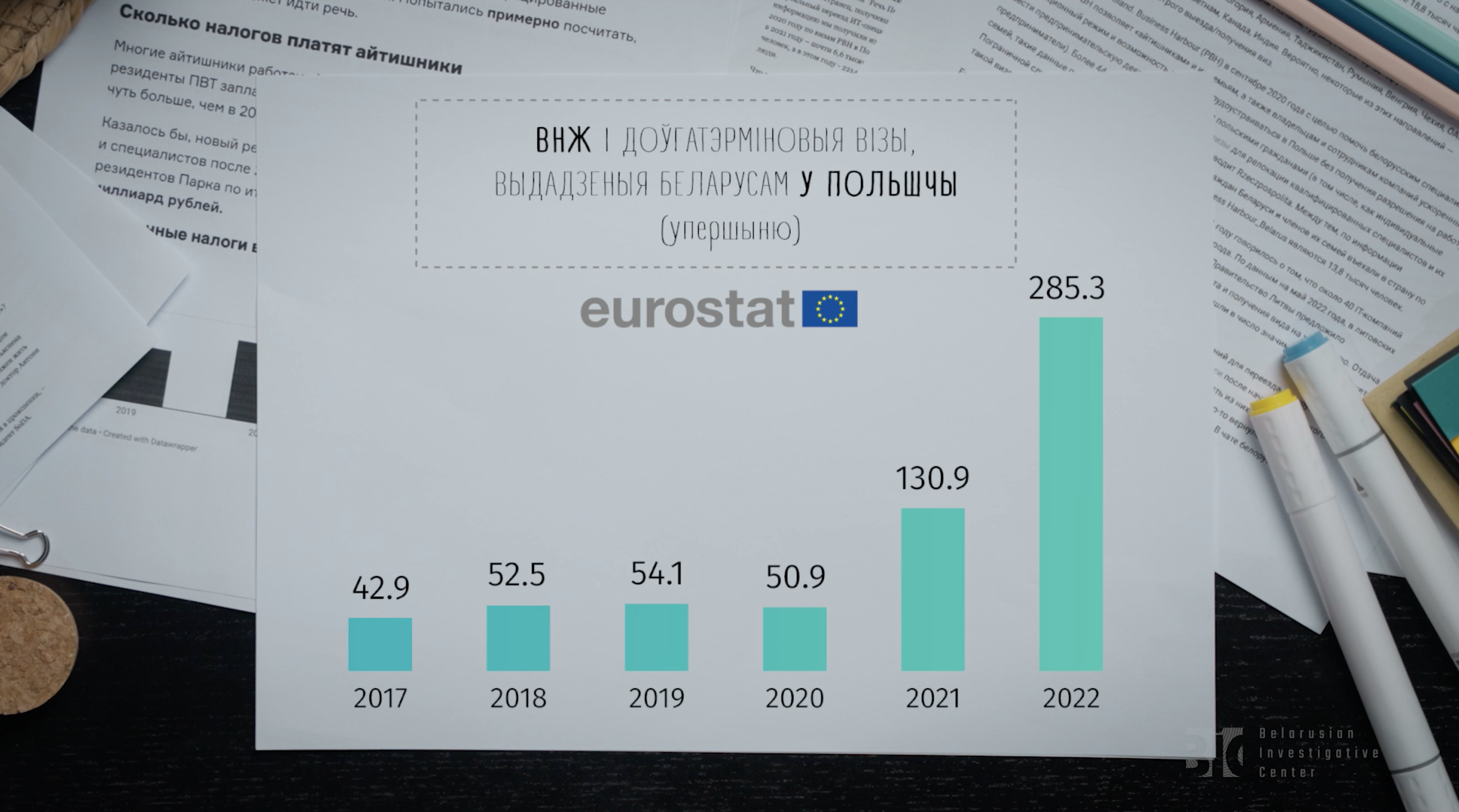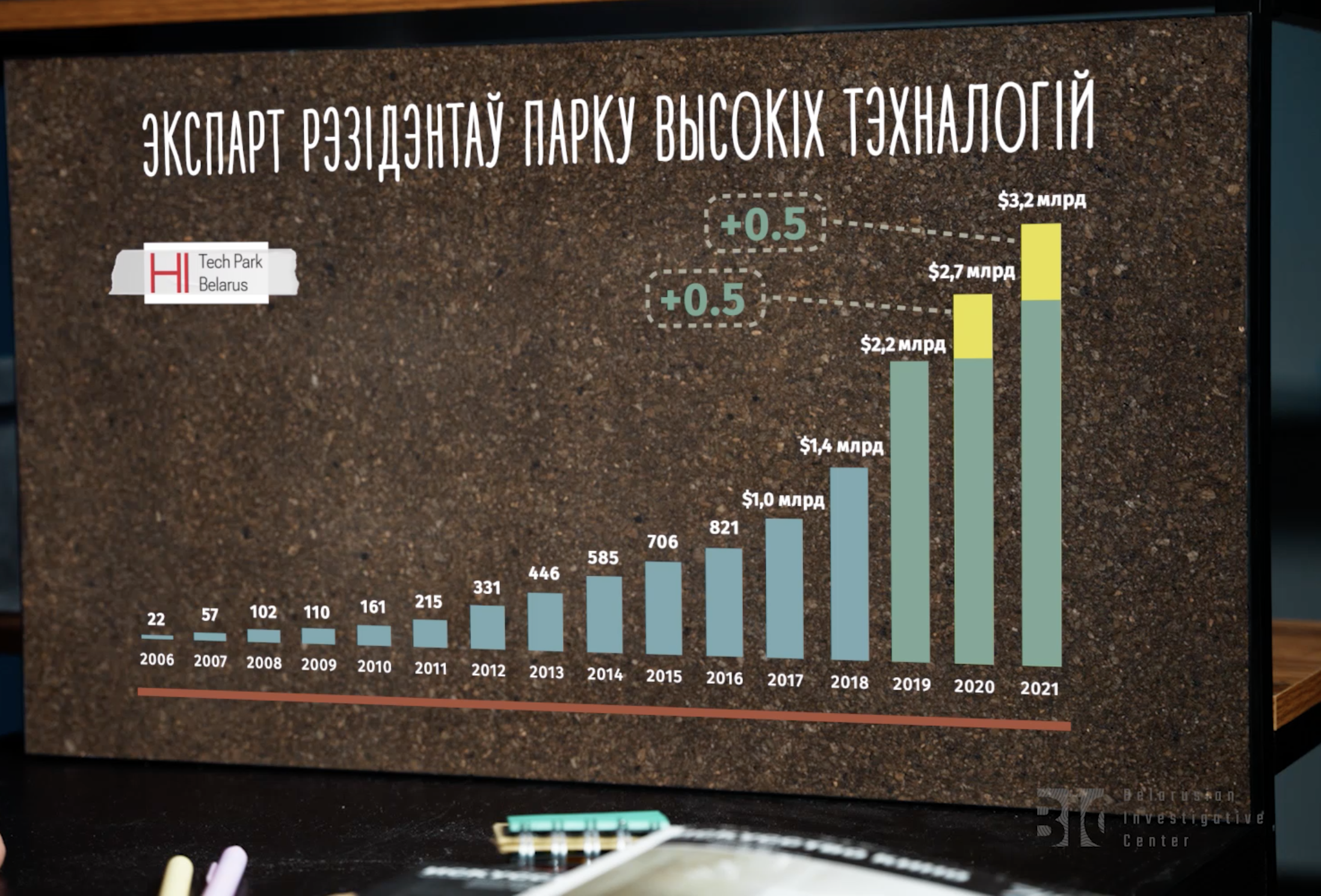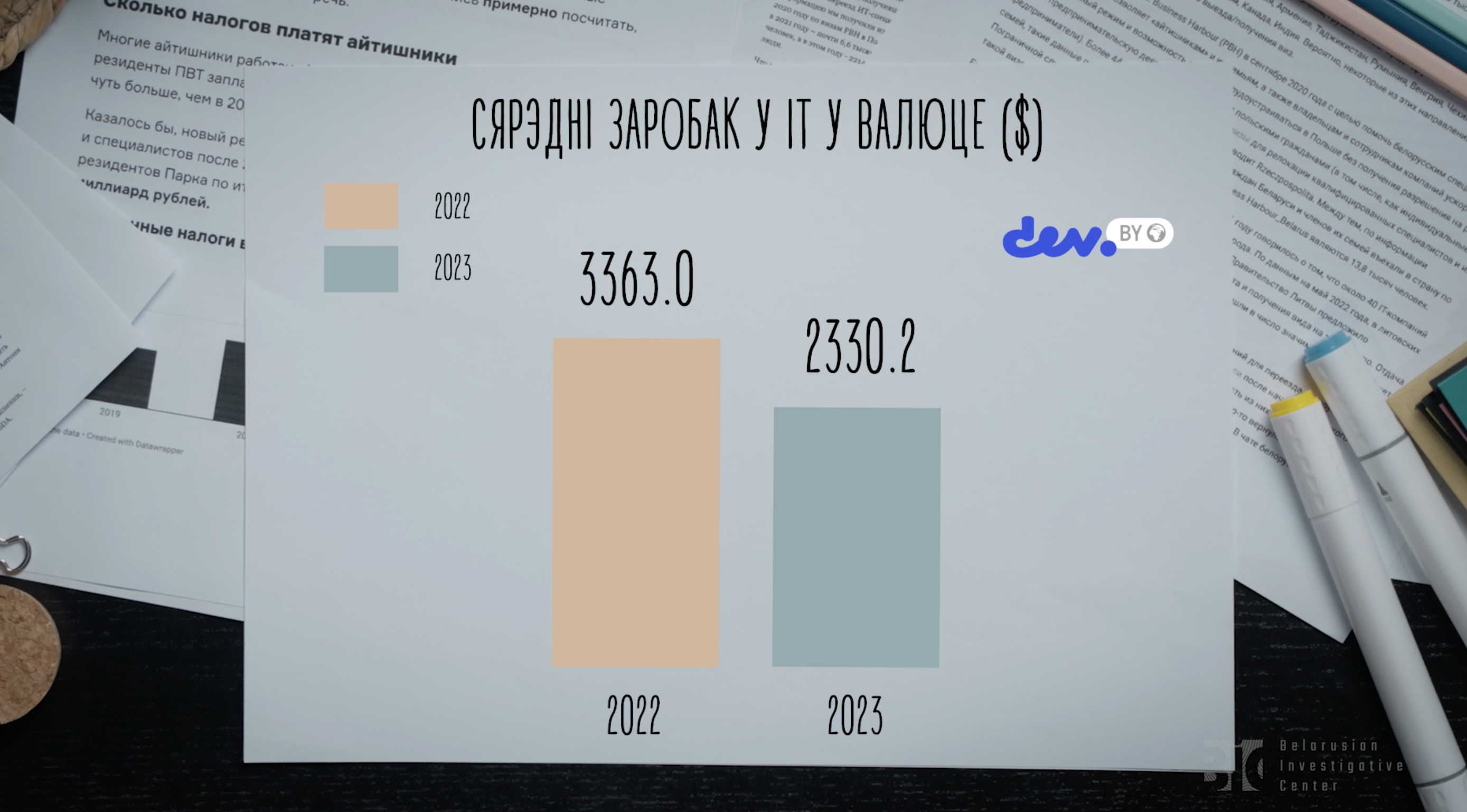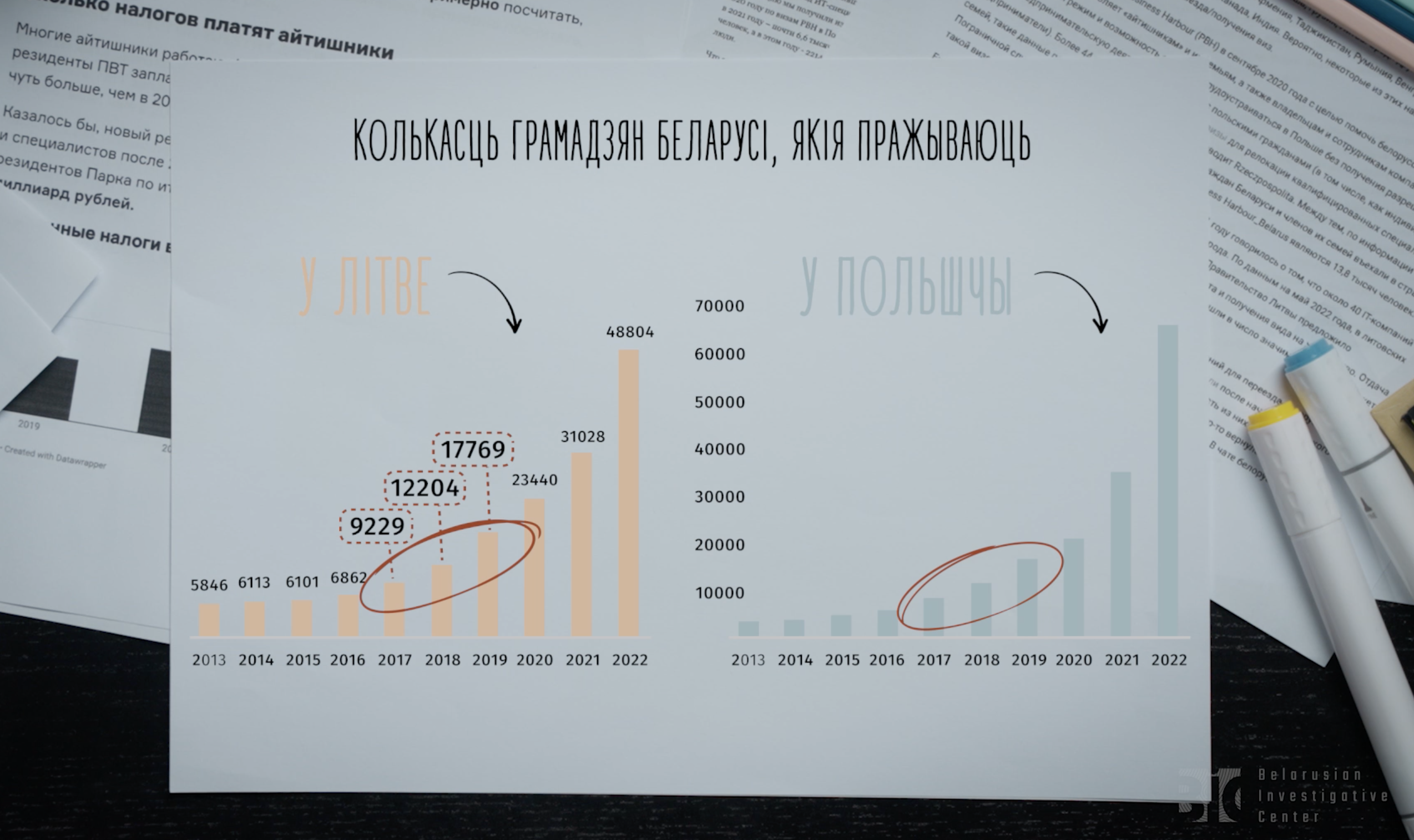Deputy Minister of Internal Affairs Mikalai Karpiankou reported that some 350,000 opponents of the current government have left Belarus. He said this to the men summoned to the training camp of the 3214 military unit on October 18, 2023.
Additionally, data from Eurostat, the EU statistical service, reveal a sharp increase in the number of migrants from Belarus following the initiation of mass political repression. In 2022, Poland alone issued approximately 300,000 first-time stay permits (residence permits and long-term visas) to Belarusians. Comparatively, in 2021, this number was 130,000, and in 2017-2020, approximately 50,000 documents were issued annually. However, not all Belarusians included in these statistics actually emigrated from Belarus.
Several factors indicate that the true number of individuals leaving the country is lower, and political repression is not the main incentive for Belarusians to relocate abroad.
"Lost" IT professionals
On November 3, Rzeczpospolita, a Polish newspaper, reported that Poland had issued approximately 100,000 visas within the IT specialist relocation program, known as Poland.Business Harbor, since 2020. The majority of visa recipients are from Belarus. However, less than 15% of the visa holders have relocated to Poland within the past three years.
Some IT specialists obtained EU visas in case the situation in Belarus deteriorated, but they have not yet left the country. They continued to provide IT services to foreign clients and remain in Belarus. It led to an increase in exports for companies within the High Technology Park (HTP) during 2020 and 2021.
Nevertheless, the situation changed after February 24, 2022, when Minsk allowed Russian forces to invade Ukraine from the Belarusian territory. According to Pavel Liber, a former top executive at EPAM Systems, "many foreign companies have stopped working with Belarus, Ukraine, and Russia because of the high risk.
This is why they put pressure on their subsidiaries and partners in Belarus to export specialists. They renegotiate contracts in Europe and continue to operate in a regular jurisdiction. While some companies remain, the majority are leaving the region.”
Additionally, businessman Aliaksandr Knyrovich, who has extensive experience in the IT sector, notes that Western clients are hesitant to collaborate with Belarus:
“I am aware of specific examples where development companies intentionally dissolved a legal entity in Belarus, following customers' demand to reveal the location of their programmers. If the programmers were based in Belarus, such companies declined to collaborate. The current situation remains unchanged due to the ongoing war. It is linked to Belarus' involvement in the war and classification as an aggressor alongside Russia. Customers from different companies take a principled stand, and in my opinion, they are the majority.”
Under these circumstances, IT workers are leaving the country in droves. Nevertheless, not all visa recipients have relocated to Poland. Some of them have moved to other countries. EPAM, for instance, expanded its offices in Poland and established new ones in Serbia and the Dominican Republic. ITechArt, the second-largest IT company in Belarus, opened an office in Uzbekistan. Belarusian IT companies have also established offices in Georgia, Croatia, Mexico and Bangladesh.
A threat to the budget
Dev.by, an online publication focusing on the IT sector, has estimated that more than 170 companies left the High Technologies Park between spring 2022 and October 2023, while over 22,000 IT specialists are believed to have left Belarus over the same period. As a result, the loss of tax revenue alone could exceed $140 million for the Belarusian budget. This loss equals more than half of all the funds annually allocated for agriculture and fisheries and twice as much as for culture. By the end of 2022, HTP exports had decreased by 15%, returning to the 2020 level.
Additionally, there has been a significant decrease in salaries for Belarusian IT workers. In February 2022, the average salary of a Belarusian IT worker was $3,300, but a year later, the earnings dropped to $2,300. This may indicate that the most skilled and highly compensated employees have left the country, according to Pavel Liber:
"Firstly, people who were offered relocation by their company left. Secondly, clients were willing to pay a higher rate [salary rate – ed.] for relocated workers. Of course, first of all, we are talking about quality specialists. They are mainly seniors, leads, and middles [top and mid-level specialists – ed.]. Juniors [those who have recently started their careers in the IT field – ed.] also left, but they were fewer in number than the others. And a significant ‘brain drain’ occurred in the country. It is quite difficult to make up for it.”
The IT sector was once a driving force of the Belarusian economy, but it has contributed to its decline, impacting citizens' incomes..
"The thing is that an IT worker who earned their few thousand dollars then took it to the grocery store and bought something Belarusian citizens made sold. They invested in Belarusian real estate... In all the goods and services in the country... This was the money they put into the economy and affected the standard of living of other citizens. However, it is one of many sectors. And it is difficult to directly link the decline in people's living standards with IT sector work. But if a person feels that their standard of living has fallen by 10%, then we can safely say that 2% of this fall is the decline of the IT sector," says Aliaksandr Knyrovich.
Motives for emigration
The majority of IT workers began to leave the country after high-paying jobs vanished. Before this, they continued to work in Belarus despite repressions.
European statistics indicate that similar reasons led most Belarusian emigrants, whose work is not related to IT, to relocate. Since 2016-2017, the number of Belarusians moving to EU countries has grown exponentially. In Lithuania, for instance, the number of Belarusian citizens increased from 6,862 in 2016 to 9,229 in 2017 and 12,204 in 2018. In 2019, the number increased to nearly 18,000 and exceeded 23,000 in 2020. In Poland, the number of Belarusians with documents allowing permanent residence varied as follows: 5,691 in 2016, 7,831 in 2017, 10,901 in 2018, 15,001 in 2019, and more than 18,000 in 2020.
The shale boom, which resulted in a nearly 50% decrease in oil prices in 2014, triggered an economic crisis in Russia and caused the Russian ruble to lose value. This in turn had a ripple effect on Belarus, leading to a prolonged recession.
In late 2014 and early 2015, the Belarusian government implemented its third major currency devaluation in less than five years. As a result, the average salary in the country dropped by one-third. For years, it has been below the $500 promised by Lukashenko in 2004, owing to the prolonged economic crisis.
The crisis in Belarus and Russia, where Belarusians traditionally went to work, led to increased emigration to Europe. This process was further encouraged by Poland and Lithuania, which introduced programs to facilitate work visas for Belarusian citizens.
Political repression has led to an increase in migration from Belarus, but economic factors continue to be the primary motivators. A 2020 survey of young people conducted by the public association Rada found that seeking safety was the third most popular reason for leaving. The second reason was the lack of prospects in Belarus, while the top motivator was finding better opportunities to earn a good living overseas.
More than half of the respondents (51.6%) expressed a desire to emigrate permanently. At the same time, nearly 40% of the participants expressed their intention to pursue temporary work overseas and then return home.








